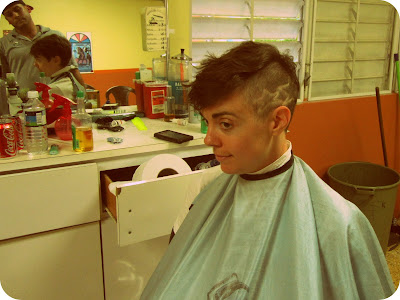SAILING THE CAICOS BANK - Sailing a Sea of Color
We're sailing on water that drinks in
light and pours it back out. Atop this glowing sea, beneath the blue
underbellies of clouds reflecting the bright light back down, we scan the
water for dangerous coral heads.
 |
| The aquamarine waters and blue clouds of the Caicos Bank. |
Here, on the Caicos Bank, a shallow
body of water ringed by aging coral islands slowly falling into the
sea, there is rarely five feet of water beneath our keel. Sometimes
the water shallows so steeply, there is less than an arms length
between our 5'3” keel and the bottom. Luckily, the bottom is soft
sand, though coral could be growing anywhere. We have waypoints that
route us through the deepest, clearest path, but our guidebooks
caution to keep a sharp look out. If we hit a coral head, it could
damage our keel.
 |
| The mainsail and even the radar reflecting the aquamarine glow of the Caicos Bank. |
At first the water is an immense,
uninterrupted sea of color. What else in nature is this color? A
hummingbird's iridescent feathers. A drop of rain glinting in the
sun. Then large, brown marks begin to blemish the seascape. Though
the water is clear as air, I can't make out what the hazy brown
patches are through the rippled backs of wind driven waves. George and
I choose to believe that these blemishes are sea grass, though we
aren't really sure. A few minutes later, we accidentally sail right
through the smudgy brown water and run to look at the depth sounder.
The instrument panel reads a steady 8.6 feet deep; the smudgy brown
patches must be sea grass.
Still, large black areas in the water
worry us most. These black stains don't look like the coral reefs I
remember from the South Pacific, which change from green to yellow
and then brown as the coral heads shallow to break the surface. If
not coral, what are they? Now, with only a foot and a half between
the keel and the bottom, there is little margin for error. If we hit
a coral head, we might bulldoze through, or, depending on the size of
the coral head, it might stop us like a brick wall, cracking the hull
or worse. Without being sure if these large black marks are coral or
not, we swing wide of them; there's no reason to play Russian
roulette with the hull. Besides, I chose this route; I charted this
course. It's not my boat, I'm only a hitchhiking temporary crew member, but if something were to happen to the boat ....
 |
| Cloud shadow? |
Tensely, with our eyes swimming in
aquamarine, we sail toward the next waypoint as clouds huddle
together behind us. The harsh afternoon sun casts deep cloud shadows
that look unfairly like the black marks in the water that might be
coral. Its hard to tell the one from the other. Eventually, cloud
shadows start to blur and then run toward the horizon while the other
black spots remain firmly in place.
At times, clouds obscure the sun
entirely and transform the translucent water into an opaque surface
that refuses to reveal what's beneath. Then we have to trust entirely
to chance as we plow through the water at six and seven knots. All
the guidebooks warned us to make this passage in good light to be
able to see obstructions in the water. We've planned well, the sun is
high and behind us, but the clouds aren't cooperating.
All day we remain vigilant; I watch on
the starboard side, George on port as we glide over neon blue-green
water glowing under our boat as if back lit by the white sand
beneath. For hours on end we steer around dangers real and imagined.
 |
| Five o'clock sun glinting on the waters of Providenciales. |
At five o'clock, as the sun sinks in
front of us, turning the surface of the water into a blinding white,
we arrive in Providenciales, or Provo, in the northwestern corner of
the Caicos Bank. After we drop anchor in Sapodilla Bay, George stretches out his hand and says, “Congratulations, we've made it
across the bank.” Did I ever have any doubt?
Unscathed, we celebrate with a beer and
a swim. Tomorrow we'll move to the South Side Marina which will be
our home base to continue our underwater exploration of the Caicos
Bank.
 |
| Anchored in Sapodilla Bay, Providenciales in the northwestern corner of the Caicos Bank. |
















